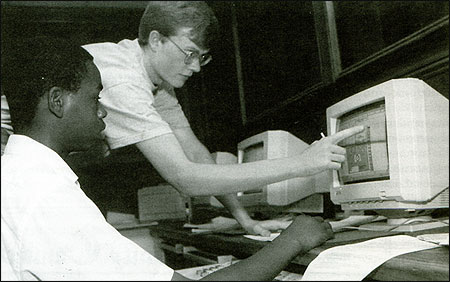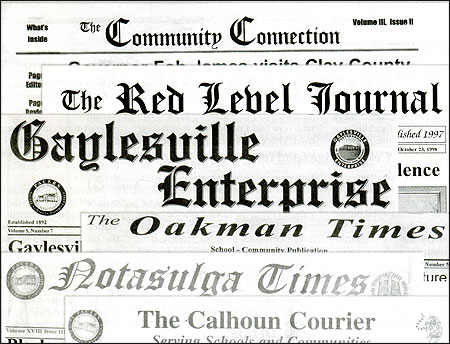
Brandon Tubbs working as a mentor to a student from the PACERS Cooperative. © Photo courtesy PACERS Photography, Program for Rural Services and Research.
Shawn “Sham” Franks, a sophomore at Oakman (Alabama) High School, once said: “You cannot have a democracy and you cannot have a community if you don’t have a way to share ideas.” His statement illustrated why it was essential for members of his community to have a shared public voice.
Having lived in Oakman all of my 19 years, I knew exactly what Sham meant. People in my town (population 964) had no forum to call their own, no means of communication to strengthen the community. With the exception of covering the high school sporting events and announcing the times of the town council meetings, the county seat paper, The Daily Mountain Eagle in Jasper, Alabama, didn’t report on what was happening in Oakman. Gossip was the only predictable means of communication available to those of us who lived in this tiny coal mining town in the Appalachian foothills.
Sham’s observation arose out of a dialogue arranged among teachers, students, community members and rural educators by the PACERS Small Schools Cooperative. Concerned about the future viability of rural communities, PACERS works in 29 small, rural public schools to cultivate dynamic ideas for teaching and learning and community building. Because of Sham’s comment, which turned out to be echoed by other students and teachers in meetings that were held around the state, the idea of community newspapers reported, written and published by high school students was born. In my town, The Oakman Times went to press for the first time in December 1993. It was a remarkable moment, for those of us who had the privilege of producing it and for members of the community who now had a newspaper to call their own. This experience transformed my life profoundly.
Today, I am a sophomore at the University of Alabama majoring in journalism. I know this is what I want to do in life because I’ve already been a journalist in my hometown. I started being one when I was a high school freshman, not just for my school and read by my peers but for my community and read by my elders.
At age 13, I became a community reporter, one of the original dozen staff members of The Oakman Times, the second newspaper in the town’s history. Business manager S.W. Vice published the town’s first paper, The Oakman News, on April 12, 1894. Sidney Busby, a senior at Oakman High, designed our paper’s original banner depicting Oakman’s heritage and present time. It flew as a symbol for The Oakman Times until October 1995 when we decided to change it in order to provide a more professional look to the paper.
I started out reporting whatever was assigned to me by the editors and watched what I thought to be well-written pieces turned into blood with the red ink of fellow classmates and teachers. I learned much of what I know now from making mistakes and having mentors there to steer me in the right direction. By my sophomore year I was the paper’s Editor. Our circulation increased from 1,000 to 2,500 in one year, and the paper expanded to 12 or 16 pages in a monthly tabloid format with a well-developed stylebook.
Students like myself sold and designed ads, created the layout for the stories, decided on and wrote editorials, reported stories and attached headlines, and shot the photos. Our staff wasn’t structured like a totem pole. Meeting deadlines and teaching and learning the necessary skills of our new trade was everyone’s responsibility, and so we incorporated a sense of teamwork into our routines. In working on the newspaper, we were no longer separated from our teachers by desks; we now learned together and from one another. Teachers used this experience and adapted it to their other classrooms.
The public nature of our work demanded that we improve in our use of the written word, in our business negotiations, and in our interviewing skills. The final product had to meet our standards as well as the standards of our community. And when we didn’t, the community let us know. One Friday morning Mr. Woods, our principal, received nine phone calls within a 30-minute span of time. The community wanted to know where the paper was. We were a few days late, and this made us realize, for the first time, how important we were becoming to the community. It was a wake up call for us as we had just entered our second year of publishing The Oakman Times.
As community members read the paper, many of their skills improved as well. Everyone bettered their lives by learning more about their community and heritage. Our community newspaper became a link between Oakman’s past and its future. Young reporters talked with elders who could make history come alive in a way books can’t because they had lived it. By understanding more about where we came from, we might have a better sense of where we were, wanted to go, and ways to get there.
The Oakman Times preserved the words, lessons and stories of people such as Papa Chick, a man who has witnessed a century of change in Oakman. People like him became our primary sources for the paper because they knew more about Oakman than anybody else did. Plus, they have unique and valuable perspectives and opinions about the way people do things today.
As journalists, we provided a forum where voices within our community could come together. As a result, we were valued as much as the community members working in the real world and earning a paycheck. No longer viewed as insignificant young people doing more damage than good, The Times staff became an essential information resource for the community and a respected advocate for civic well-being.
For example, our paper served as the sole source of community information when SONAT, a Southeastern natural gas provider, planned to lay a pipeline within sight of the elementary school. This plan was regarded as a threat to the lives of Oakman’s children and property by many in the community. The county seat paper reported that a pipeline was coming through Oakman and left it at that. Because of our coverage, people were informed of community meetings, and those unable to attend still had access to vital and accurate information.
Our publication continued to meet the information need when reporting on rural transportation issues. When the state planned to remove and rebuild Tubbs Bridge, which is the only safe means of getting to Oakman from above Lost Creek, the county seat paper did not report on this decision. It was The Oakman Times’s reporters who kept in contact with the state director of highway transportation and informed its readers about the possible loss of access and kept them updated on any changes. And when builders of Corridor X, a new interstate system connecting Memphis, Tennessee and Birmingham, Alabama, condemned land in the area, our reporters interviewed the people whose homes were demolished to make way for the road. The county seat paper simply reported that Corridor X was coming and discussed its perceived economic benefits.
Through these experiences, I understand what journalists go through on a daily basis. I gained a sense of respect for other journalists, but I also cast a more informed and critical eye on their practice. Frankly, as a profession, journalism could do better.
The Oakman Times didn’t latch on to a story like a tick to an old hound dog. There was no harassing people for an interview, but a way was always found to obtain necessary information. No attention, except (save) editorials, was devoted to the Clinton scandal because we decided not to dwell on national stories full of sensationalism that have no direct and present link to our community. This goes for stories like the murder of JonBenet Ramsey, too. It’s not that controversy was avoided. We reported aggressively on issues relevant to the people who live in Oakman and discussed national issues only in the context of how they affected us in our daily lives in our community.
Nor did the paper present the news in a dry manner. The Oakman Times brings a certain flavor to its news coverage. We sat and talked with folks. Our reporters were more concerned about talking with people and conveying a clearer sense of meaning to our stories. We listened instead of just taking notes. We cared instead of just reporting. We were vested in the community; we were concerned because it affected our lives and the people we cared about.
The Oakman Times didn’t confuse reporting with analysis or agenda setting. The paper didn’t use “experts” to tell Oakman what a coal mine closing meant. Our coverage told how the miners planned to feed their children and send them to school and asked them what options were available to them.
We presented facts as we uncovered them and let the miners tell their stories and then let our readers decide for themselves how events affected the community.
I once read where Jeannine Guttman, Executive Editor of The Portland (Maine) Press Herald, said in a national civic journalism workshop that “citizens were missing from our stories because we didn’t value their opinions,” that “our own reporters didn’t want to talk to the public.” She questioned the relationship between giving people ways to share ideas and the well-being of our democracy just as Sham did. She wondered if her colleagues were “hurting democracy by ignoring the public.”
Unlike many newspapers, our publication is not owned by some big out-of-town corporation which shuffles editors in and out, not allowing them to learn about the community for which they write. In an age of media consolidation, only 125 papers publish in Alabama today, compared with 1,000 at the turn of this century. Competition and commercialism is not a priority for The Times; community and the quality of our democratic and civic life is. We understand the power of individual voices, spoken by and for members of that community.
Perhaps it’s time for a “sandlot” renewal of journalism, in which stories are written out of love for the people they are about and respect for their experiences and opinions. Journalism should be as conscious as Wendell Berry, yet as entertaining as Lewis Grizzard, as encompassing as the Bible, and as interesting and meaningful as Grandpa’s stories. Perhaps this is the utopian standard, but even so, the goal of journalists should be to reach it.
Today’s journalists should understand that they are part of the community (even if that community is our nation or our planet), and should be conscious of their role within this community. Their focus should move away from being detached professionals to being vested members of communities where they live and work. Students who now report for and publish The Oakman Times continue to uphold this community approach and their work and the response it receives reinforce the necessary role newspapers play in the life and preservation of communities. Drawing from Oakman’s experience, I urge journalists to stop talking about people through issues. Responsible journalism requires talking to people about issues.

These newspapers were published by students in the PACERS cooperative. This effort to engage young people in journalism exists in 29 rural public schools.
Brandon Tubbs is from Oakman, Alabama. As a sophomore majoring in journalism at the University of Alabama, he writes for university publications including The Communicator and The Crimson White. He has interned at The Daily Mountain Eagle in Jasper, Alabama. He is now employed by the Program for Rural Services and Research working as a mentor to other student-run community newspapers within the PACERS Cooperative. He plans to enter the journalism profession with utopian standards.



